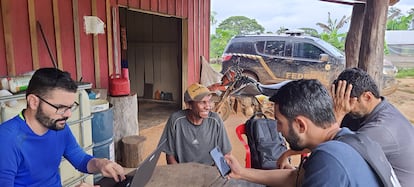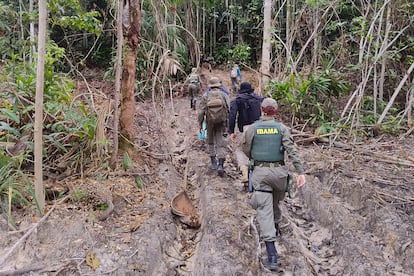
His body collapsed under the tree trunk. The crash foreshadowed disaster: Francisco Araújo Maciel, 45, thought he was dying. He didn’t see it coming and doesn’t remember exactly how it happened. On the morning of April 24, a large piece of the tree he was sawing tore his collarbone when it fell on him. This set off an ordeal that lasted more than seven hours and stretched from the heart of the forest to the nearest hospital in the remote southern Brazilian state of Amazonas.
Men working next to him discovered his body lying unconscious on the ground. They removed the suitcase from his chest and placed Araújo on a mattress in the back of a small, makeshift tractor. His broken bones creaked as the group drove through dense jungle to take him to a nearby river, where they would put him on a boat bound for Manicoré. Shortly before they arrived, federal labor inspectors found them. “When we saw him, we thought he had a punctured lung. I thought he wouldn’t survive,” recalls Magno Riga, one of the inspectors. ‘I can’t imagine how much he suffered. He was very lucky to survive.”
The inspectors had traveled from the national capital Brasilia to rescue fifty people from slave labor in the jungle. Araújo – along with the other men – had been lured by recruiters to work in what would become one of the largest largest illegal deforestation operationS in the region this year, which destroyed nearly 1,300 hectares of Amazon rainforest between January and April. Nothing the men were promised came to fruition: they ended up being subjected to conditions comparable to modern-day slavery.
“These people were placed in the worst working conditions by criminal groups dedicated to exploiting the region’s resources. (These criminals) exploit many people from vulnerable communities,” said Riga, who coordinated the rescue operation after a complaint was filed by local authorities. The workers – from several cities in the northern states of Amazonas and Rondônia – were on site for almost three months. They slept under canvas tents, worked long hours without protective equipment and, because they had no access to drinking water, had to cook, bathe and drink red water from a stream, which had been polluted by the deforestation process.
The men also went into debt to buy the chainsaws they used to cut down the trees, for which they had to pay 3,000 reais (about $500), which was deducted from their wages without prior approval. The same thing happened with their food rations.
 The rescue tractor that transported Francisco Araújo, in the municipality of Maricoré.MTE
The rescue tractor that transported Francisco Araújo, in the municipality of Maricoré.MTE
“We have suffered humiliation. They treated us badly,” complains Francisco Araújo Maciel, who underwent surgery in a hospital in Porto Velho. He has since returned to his home in Humaitá, where he lives with his sister and close to his children, who are five and eight years old. While he was recovering in the hospital, Riga visited him a few times. To this day, the inspector supports him so that he can regain his dignity and his rights. This is a fundamental part of the work of Riga and his team.
Araújo took out special unemployment insurance for three months because he was subject to it slave labor. However, he is now unable to work in forestry due to the disability resulting from the accident. He’s trying to get a disability certificate. But because he doesn’t have a signed employment contract, he finds it difficult to receive government benefits. “I can’t work anymore. And I don’t know how I’m going to rebuild my life, because I have no education. I can’t read, I don’t know how to write. I only know how to do manual labor,” he complains.
Work akin to slavery is a reality in many regions of Brazil. Although the exact figures surrounding modern slavery are difficult to measure, authorities rely on reports of labor abuse: 3,422 reports were filed in 2023, or 61% more than in 2022. This is the highest number recorded since the establishment of a dedicated in 2011. According to data from the Ministry of Labor and Employment in the largest South American country, 3,190 workers were rescued from such conditions in 2023 – the highest number since 2009, when 3,765 people were rescued.
Brazil has been actively fighting this problem since the 1990s. In 1994, the Organization of American States (OAS) filed a petition against Brazil for human rights violations in the case of José Pereira, a worker who was shot after trying to flee a farm in Pará state, where he and a colleague – who were murdered – were held as slaves. In response, the South American country established the Special Mobile Inspection Group (GEFM) at the Ministry of Labor and Employment a year later. And in 2003, the country established the National Commission for the Eradication of Slave Labor, which draws up the so-called “dirty list” of companies and individuals convicted of slave labor. The criminal code was also updated to strengthen penalties for these types of crimes.
Magno Riga – who has been working in the field of labor rights for twelve years – is one of the officials coordinating the GEFM. This team works throughout the country through field operations and intervenes where there are suspected violations of the penal code for slave labor. The group has faced death threats, direct attacks and even restrictions on their freedom of movement. But none of this has stopped them. Over the past thirty years, the organization has rescued more than 60,000 people. Their cases range from slave labor in southern Brazil and abuse on soy plantations in Goiás to the exploitation of people in gold mines in the Amazon and the trafficking in vulnerable migrants – from countries like Bolivia – to illegal clothing factories in São Paulo.
 Magno Riga and his team, in the Altamira region.MTE
Magno Riga and his team, in the Altamira region.MTE
One of GEFM’s recent focuses has been expanding its presence in the western Amazon, where reports of slave labor are rare. This problem is exacerbated in areas where the Brazilian state has the most difficulty accessing populations. In such regions it is difficult to inspect and punish the owners of these species illegal mining and deforestation siteswho – in addition to profiting from the timber and mineral trade – tend to illegally sell deforested land to ranchers.
“Many of these criminals act indirectly, through various intermediaries. This makes it difficult to punish the main offenders, especially in hard-to-reach regions,” said Commissioner Adriano Sombra, head of a special team of the Brazilian Federal Police that fights crimes against the environment in Amazonas state. “The only alternative to protecting these communities is to completely stop illegal activities. But the territory is very large. This remains a challenge.”
The lives of many workers like Araújo are deeply scarred by the history of exploitation of the Amazon rainforest. In the first half of the last century, the Brazilian government stimulated population migration to the deep Amazon region. The intention was to develop the region – already inhabited by indigenous communities – by exploiting its resources.
Major highways such as the Trans-Amazon were created by destroying part of the forest to connect the region with the rest of Brazil. Mining, ranching, and logging were the economic roots of many of the new towns. Some of these cities were built without much planning and condemned their residents to poverty. Deforestation drove out animals and reduced production of fruits like açaí, while illegal mining polluted waterways and killed fish. Therefore, most of the jobs available in these countries are the same jobs they are destroying.
“I had to work to earn a living, to buy food and things for the house, so I worked illegally,” says Araújo, who warns that nature takes its toll on your body. “If you destroy it, sooner or later it will charge you for what it has endured.”
 The rescue of Francisco Araújo, in Maricoré.MTE
The rescue of Francisco Araújo, in Maricoré.MTE
At many deforestation sites – like the one the Riga team raided in late April – satellite dishes (from companies like billionaire Elon Musk’s Starlink) are even used to quickly call for reinforcements and warn of inspection operations, delaying authorities. attempts. In law enforcement operations in the south of Amazonas state, it is increasingly common for leaders of illegal activities to disappear before inspectors arrive.
Riga believes the value of his work lies in the lives it changes. The real challenge is to create significant change that will lift these people out of the vulnerability that enslaves them. “Brazil is perhaps the most unequal country. This is a construction of centuries, mainly based on the (institution of) slavery that shaped the country and its people,” he explains. “As long as we are a country of enslaved people and slave traders, it will be necessary for us to strive to change this reality.”
Translated by Avik Jain Chatlani
Sign up for our weekly newsletter to get more English-language coverage from EL PAÍS USA Edition
Leave a Reply